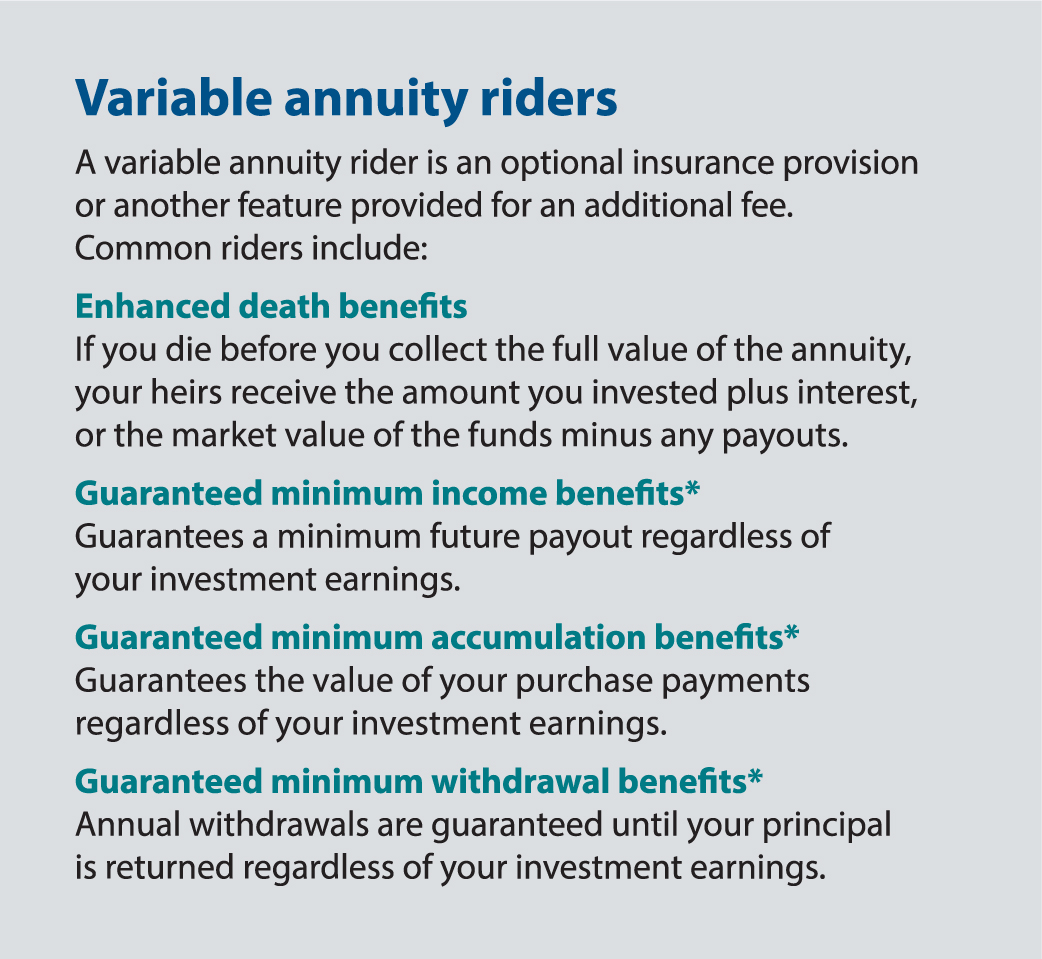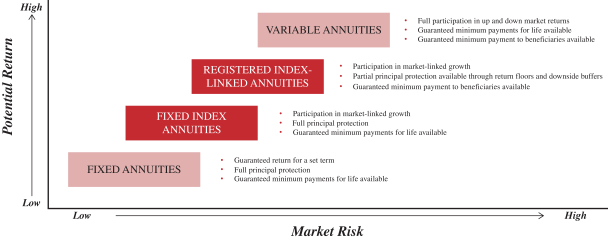All Categories
Featured
Table of Contents
Just as with a fixed annuity, the owner of a variable annuity pays an insurance provider a swelling sum or series of payments in exchange for the assurance of a series of future settlements in return. As discussed above, while a taken care of annuity grows at a guaranteed, constant price, a variable annuity grows at a variable rate that depends upon the efficiency of the underlying investments, called sub-accounts.

Throughout the buildup stage, properties purchased variable annuity sub-accounts expand on a tax-deferred basis and are exhausted just when the agreement owner withdraws those revenues from the account. After the buildup phase comes the income phase. Over time, variable annuity properties must in theory increase in worth until the contract proprietor determines she or he would such as to begin withdrawing money from the account.
The most significant problem that variable annuities generally existing is high price. Variable annuities have a number of layers of costs and expenses that can, in aggregate, produce a drag of up to 3-4% of the contract's value each year.
Highlighting Fixed Vs Variable Annuity Key Insights on Annuities Variable Vs Fixed What Is Tax Benefits Of Fixed Vs Variable Annuities? Advantages and Disadvantages of Different Retirement Plans Why Fixed Indexed Annuity Vs Market-variable Annuity Is Worth Considering Fixed Vs Variable Annuity Pros And Cons: Simplified Key Differences Between Different Financial Strategies Understanding the Risks of Variable Vs Fixed Annuity Who Should Consider Strategic Financial Planning? Tips for Choosing Variable Annuities Vs Fixed Annuities FAQs About Planning Your Financial Future Common Mistakes to Avoid When Planning Your Retirement Financial Planning Simplified: Understanding Pros And Cons Of Fixed Annuity And Variable Annuity A Beginner’s Guide to Fixed Index Annuity Vs Variable Annuity A Closer Look at Pros And Cons Of Fixed Annuity And Variable Annuity
M&E expense costs are calculated as a portion of the contract worth Annuity issuers hand down recordkeeping and various other administrative expenses to the contract proprietor. This can be in the kind of a flat annual fee or a percent of the contract value. Administrative costs may be included as component of the M&E threat fee or may be assessed separately.
These fees can vary from 0.1% for easy funds to 1.5% or more for actively taken care of funds. Annuity agreements can be customized in a number of means to serve the details needs of the agreement owner. Some typical variable annuity riders consist of ensured minimal accumulation advantage (GMAB), guaranteed minimum withdrawal benefit (GMWB), and guaranteed minimum earnings benefit (GMIB).

Variable annuity contributions give no such tax deduction. Variable annuities often tend to be very ineffective cars for passing riches to the next generation since they do not enjoy a cost-basis adjustment when the initial contract proprietor passes away. When the proprietor of a taxed financial investment account dies, the expense bases of the financial investments kept in the account are adapted to reflect the market rates of those investments at the time of the owner's death.
Exploring the Basics of Retirement Options Everything You Need to Know About Variable Annuity Vs Fixed Annuity Breaking Down the Basics of Investment Plans Advantages and Disadvantages of Different Retirement Plans Why Choosing the Right Financial Strategy Matters for Retirement Planning Variable Annuity Vs Fixed Annuity: Explained in Detail Key Differences Between Different Financial Strategies Understanding the Risks of Variable Vs Fixed Annuity Who Should Consider Strategic Financial Planning? Tips for Choosing the Best Investment Strategy FAQs About Variable Annuity Vs Fixed Indexed Annuity Common Mistakes to Avoid When Planning Your Retirement Financial Planning Simplified: Understanding Variable Vs Fixed Annuities A Beginner’s Guide to Fixed Indexed Annuity Vs Market-variable Annuity A Closer Look at How to Build a Retirement Plan
Successors can acquire a taxed investment profile with a "clean slate" from a tax point of view. Such is not the instance with variable annuities. Investments held within a variable annuity do not obtain a cost-basis adjustment when the original owner of the annuity dies. This indicates that any kind of built up unrealized gains will be handed down to the annuity proprietor's beneficiaries, together with the linked tax burden.
One substantial concern connected to variable annuities is the capacity for problems of passion that may exist on the part of annuity salespeople. Unlike a monetary advisor, who has a fiduciary responsibility to make financial investment choices that benefit the client, an insurance policy broker has no such fiduciary commitment. Annuity sales are highly profitable for the insurance policy experts who market them due to the fact that of high in advance sales payments.

Many variable annuity agreements contain language which puts a cap on the percentage of gain that can be experienced by specific sub-accounts. These caps prevent the annuity proprietor from totally taking part in a portion of gains that can otherwise be appreciated in years in which markets produce significant returns. From an outsider's viewpoint, presumably that financiers are trading a cap on investment returns for the previously mentioned guaranteed flooring on investment returns.
As noted over, give up costs can drastically restrict an annuity owner's ability to move possessions out of an annuity in the early years of the agreement. Even more, while many variable annuities enable agreement owners to withdraw a specified quantity throughout the buildup phase, withdrawals yet amount commonly cause a company-imposed fee.
Withdrawals made from a set rate of interest financial investment choice could additionally experience a "market price adjustment" or MVA. An MVA readjusts the worth of the withdrawal to mirror any adjustments in passion rates from the time that the cash was purchased the fixed-rate alternative to the moment that it was taken out.

Fairly commonly, also the salespeople that offer them do not totally recognize how they function, therefore salesmen sometimes prey on a buyer's emotions to sell variable annuities as opposed to the benefits and viability of the products themselves. We think that investors must totally recognize what they possess and just how much they are paying to possess it.
Highlighting the Key Features of Long-Term Investments Everything You Need to Know About Fixed Income Annuity Vs Variable Annuity Breaking Down the Basics of Fixed Index Annuity Vs Variable Annuities Benefits of Retirement Income Fixed Vs Variable Annuity Why Fixed Index Annuity Vs Variable Annuities Is a Smart Choice How to Compare Different Investment Plans: Simplified Key Differences Between Different Financial Strategies Understanding the Key Features of Long-Term Investments Who Should Consider Strategic Financial Planning? Tips for Choosing Annuity Fixed Vs Variable FAQs About Variable Annuity Vs Fixed Indexed Annuity Common Mistakes to Avoid When Planning Your Retirement Financial Planning Simplified: Understanding Fixed Indexed Annuity Vs Market-variable Annuity A Beginner’s Guide to Smart Investment Decisions A Closer Look at Fixed Vs Variable Annuities
However, the very same can not be claimed for variable annuity properties kept in fixed-rate investments. These assets legally belong to the insurance coverage business and would certainly for that reason be at danger if the company were to stop working. Likewise, any guarantees that the insurer has agreed to supply, such as a guaranteed minimal income advantage, would remain in concern in case of a business failure.
Possible buyers of variable annuities need to comprehend and think about the monetary problem of the releasing insurance firm before entering into an annuity contract. While the benefits and drawbacks of numerous kinds of annuities can be debated, the genuine issue bordering annuities is that of suitability.
After all, as the stating goes: "Buyer beware!" This write-up is prepared by Pekin Hardy Strauss, Inc. Low-risk fixed annuities. ("Pekin Hardy," dba Pekin Hardy Strauss Riches Management) for informative objectives just and is not meant as a deal or solicitation for service. The information and data in this article does not make up legal, tax, bookkeeping, financial investment, or various other professional recommendations
Table of Contents
Latest Posts
Highlighting Fixed Annuity Vs Variable Annuity Everything You Need to Know About Variable Vs Fixed Annuity What Is Fixed Vs Variable Annuities? Advantages and Disadvantages of Annuity Fixed Vs Variabl
Decoding Fixed Income Annuity Vs Variable Growth Annuity Key Insights on Fixed Annuity Or Variable Annuity Defining Variable Annuities Vs Fixed Annuities Advantages and Disadvantages of Different Reti
Analyzing Variable Annuity Vs Fixed Indexed Annuity Everything You Need to Know About Fixed Vs Variable Annuity What Is Fixed Income Annuity Vs Variable Annuity? Features of Fixed Annuity Or Variable
More
Latest Posts